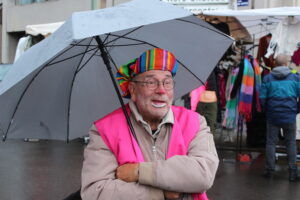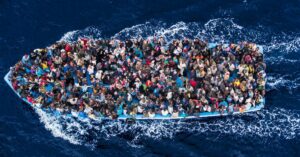Share
Sonia Shah is a science journalist and has won multiple prizes for her books on science, politics, global health, and human-animal relations. Her most recent book is called The Next Great Migration: The Story of Movement on a Changing Planet. For Shah, this story of migration is a personal one. Her Indian parents moved to the US in the 1960s, when there was a great demand for highly skilled workers. During her youth, she traveled back and forth numerous times to visit her family in Mumbai. Some time ago, she herself moved to Australia for a few years with her husband and children. She currently lives in Baltimore, the US, where she is also active in local politics.
The book starts with an elaborate story about how Shah and a researcher went looking for the checkerspot butterfly, a beautiful, yet fragile creature. It is mostly found on the west coast of the US. Flying low to the ground, it only eats one plant, and it lives for only ten days. It is known for being sedentary and thus relies on the environment it finds itself in. However, due to this dependency, it was one of the first creatures to show how its life would be affected by climate change. It was long believed that the butterfly nearly went extinct until it was discovered that the checkerspots were moving northward at a rate of twenty kilometers every ten years. This not only showed that the animal was not going extinct, but that it was not sedentary either. The butterfly effect, the idea that one small thing can have a great impact, is real, because, thanks to this discovery, hundreds of other animals were proven to be on the move, rather than going extinct.
This butterfly effect is visible throughout the book because Shah will take you through the 18th century all the way until now. She discusses how European travelers in the 18th century described other people: they made clear distinctions between European and non-European. These distinctions were exaggerated stories mostly based on myths, but because travel was not as common as it is now, these stories could not be fact-checked. One of the theories as to why these differences were exaggerated, has to do with the new way of travel. Before, one would travel hundreds of miles over land, encountering hundreds of people, whose backgrounds would blur together. There would be no real distinction anymore. Shah describes it as slowly going into a hot bath. However, once travelers started crossing the sea with a boat, they would not see other people for months. So, when, after months of traveling, they encountered new people who looked different than they did, they felt a shock, like going into a cold bath. We would now call this a culture shock. The travel literature from back then was not about accurate recounts of travels, but about discussing foreignness and superiority.
These senses of foreignness and superiority carried well into the 19th century when it was argued that mixing the superior race of Europeans with sub-races of foreigners would lead to disasters. It was also believed that if people would overpopulate, it would eventually lead to self-destruction. The discovery of DNA halfway into the 20th century would finally show that there were no clear biological differences between human ‘races’.
Even though this knowledge is well known now, these ideas from the 18th century are still relevant for our modern societies. They explain the fear of movement, the fear of others, and racism and discrimination. However, as we have seen, both people and animals do not stay in the same place. Yet, the ideas of sedentism and the idea that plants, animals, and people belong in certain places, are still taught. Even though these ideas are based on centuries-old taxonomies.
This book thus shows how the misinformation of the past few centuries still shapes our world today. As much as that idea is intriguing and thought-provoking, it is an incomplete story. For a book that focuses on migration, Shah neglects to discuss the very reason why most people are continuously on the move. Shah writes that ”we can ask migrants why they move, but it’s not necessarily possible for them to answer, at least not in the direct and simple way we’d like”. One can agree with her that reasons to migrate are often complex and there is no single answer. However, that does not mean that neglecting the growing body of literature on migration aspirations and capabilities is the right way to go about it. It would have been an improvement if she had looked more into the reasons for migration, rather than as a way of survival and adaptation to the changing environment. That is because there are so many reasons why people would migrate, ranging from fleeing war, conflict, and economic hardship to family reunion and education. Migration is not just about surviving; it is also about living.
As much as the story describes the ways in which migration takes place in the world, Shah does not define what the next great migration will be. Rather, she argues that we should change the way we look at migration, for the sake of the next great migration. She finishes the book on a hopeful note, in which we should no longer see migration as a problem, but rather as a solution. That is because as long as there are living people, plants, and animals on this planet, migration will not stop. Therefore, by changing the ways in which we think about migration, we can create our own butterfly effect.


